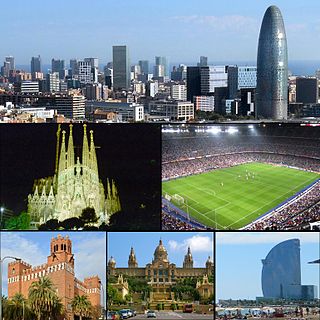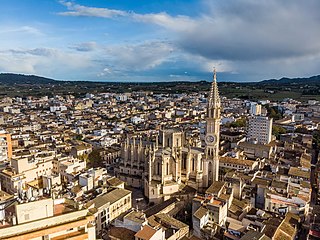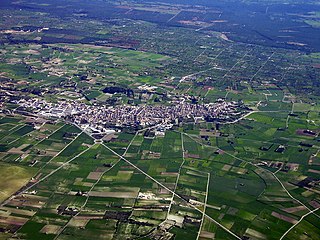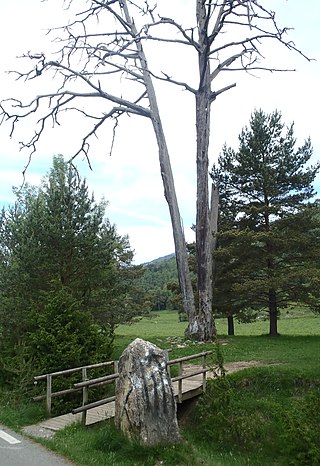This article needs additional citations for verification .(December 2016) |
Establiments is a residential district in the Balearic Islands, northwest of Palma de Mallorca, Spain. The name is derived from the Catalan word for "establishments".
This article needs additional citations for verification .(December 2016) |
Establiments is a residential district in the Balearic Islands, northwest of Palma de Mallorca, Spain. The name is derived from the Catalan word for "establishments".
Establiments dates to the 16th century, although the area surrounding the district has been occupied for much longer.
Prehistoric remains were found in the Son Bauçà caves and Ca’n Mallol, as well as some talaiòtic remains.
During the period when much of Spain was under Muslim rule, approximately from the 700s-1400s AD, agriculture developed in the area.
After the conquest of Mallorca by the Kingdom of Aragón, the land was transferred to Nunó Sanç. For centuries, the agrarian structure of the area was rooted in possessions of large estates. Establiments emerged from upland rustic parceling of these possessions." The name Establiments comes from the word for "establishments" or possessions in Mallorquin, a dialect of Catalan.
The first possessió parcelled was Son Gual which is now Establiments Vells, named El Rutló. The refuge d'es Rutló was documented for the first time in 1584, with 14 parcels. In the 12th century began the parceling of d'es Muntant from the "possessió" de Sarrià, which eventually came to be known as Establiments Nous. In 1685 the vells had 69 parcels and the nous had 33.
For several centuries Establiments was part of Esporles, but after a time, an independent municipality was formed. In the Cardenal Despuig map of 1785 the large "possessions" of Es Canyar, Son Cotoneret, Son Gual, Bunyolí (documented around 1402), Sarrià, Son Morlà, Son Mallol i Son Berga appear, most as the property of families of nobility. In 1776 Son Berga Nou was built. Considered one of the most beautiful Majorquin "possessions" it was the property of the Safortesa family.
In 1837, Establiments was separated from Esporles and became an independent municipality. In 1847, it had a population of 1460. 367 houses occupied an area of 22.55 km2 (8.707 mi2). Throughout the 19th century the municipality's principal occupation was farming, and the principal crops were wheat, barley, almonds, olive oil, carob beans and legumes. During the 1870s, the principal "possessiones" were Sarrià (426 ha), Bunyolí (376 ha), Son Gual (195 ha), Son Morlà (95 ha), and Es Canyar (84 ha).
In the first half of the 20th century three tissue factories, a shoe factory and a mosaics factory were established.
In 1910, Establiments was annexed by Palma de Mallorca and officially gained the category of neighborhood. Many of its original features were preserved, similar to the neighborhood of Son Espanyol. It is likely that the reason for its annexation was a combination of economic troubles and political squabbling between liberal and conservatives.
In 1926, Establiments obtained an electric tram line whose trolley cars departed from Sant Miquel Sreet. This tram served until 1959 when it was replaced by a bus line. In 1933 Joan Colom's cement factory started the quarries exploitation, which caused a lot of problems. During the Spanish Civil War prominent figures such as the administrator of Socialist Youngsters Antoni Roca Lladó, and the esporlerist socialist and Establiments resident, Gabriel Calafell Serra, were imprisoned and executed. This caused some residents to seek refuge.
A tourist boom in the 1950s decreased agriculture and many factories closed. An important collective of immigrants from the Peninsula arrived, which the native people called strangers (forasters in Catalan). [1]

The district borders the municipalities of Esporles and Puigpuñent to the north and west, respectively. It borders the districts of Son Anglada and Secar de la Real to the south and the suburb of Son Espanyol to the east.

The Coat of arms is a visual of a blue arm holding a sword painted on a red background.

Barcelona is a city on the coast of northeastern Spain. It is the capital and largest city of the autonomous community of Catalonia, as well as the second most populous municipality of Spain. With a population of 1.6 million within city limits, its urban area extends to numerous neighbouring municipalities within the Province of Barcelona and is home to around 4.8 million people, making it the fifth most populous urban area in the European Union after Paris, the Ruhr area, Madrid, and Milan. It is one of the largest metropolises on the Mediterranean Sea, located on the coast between the mouths of the rivers Llobregat and Besòs, and bounded to the west by the Serra de Collserola mountain range, the tallest peak of which is 512 metres high.

Mallorca, or Majorca, is the largest island in the Balearic Islands, which are part of Spain and located in the Mediterranean.

Palma is the capital and largest city of the autonomous community of the Balearic Islands in Spain. It is situated on the south coast of Mallorca on the Bay of Palma. The Cabrera Archipelago, though widely separated from Palma proper, is administratively considered part of the municipality. As of 2018, Palma Airport serves over 29 million passengers per year.

Manacor is a town and municipality on the island of Mallorca, part of the Spanish autonomous community of the Balearic Islands. It is the second largest town in Mallorca, after the capital of Palma. The municipality has tourist areas such as Porto Cristo, site of the famous Caves of Drach, and Cales de Mallorca. Manacor has one of the busiest street markets on the island, held every Monday morning. Manacor is famous for high-quality wood furniture manufacture and artificial pearls.

Calvià is a municipality on the island of Majorca, part of the Spanish autonomous community of the Balearic Islands. It is located in the southwestern part of the island of Majorca, between the Serra de Tramuntana and the Serra de Na Burguesa. The municipal seat is the town of Calvià Vila.

Alaró is a small municipality in the district of Raiguer on Majorca, one of the Balearic Islands, Spain, Europe.

Llucmajor is the largest municipality of the Balearic Island of Mallorca.

The University of the Balearic Islands is a Balearic Spanish university, founded in 1978 and located in Palma on the island of Majorca. The university is funded by the autonomous Government of the Balearic Islands.

Cornellà de Llobregat is a municipality in the comarca of the Baix Llobregat in Catalonia, Spain. It is situated on the left bank of the Llobregat River. It is in the south-western part of the Barcelona metropolitan area and is part of the wider urban area. It houses one of the three La Liga football clubs from Catalonia, RCD Espanyol.

Esporles is a locality and Spanish municipality of the autonomous community of the Balearic Islands. Situated on the island of Majorca, around the zone of the Serra de Tramuntana. It's about 15 km from Palma de Mallorca. The town is divided into Vilavella and Vilanova. In its territory it also includes small urbanizations, like Ses Rotgetes de Canet y Es Verger.

Santa Margalida is a municipality with a population of 10,204 located in the northeast of the Spanish Balearic Island Majorca.

Puigpunyent is a municipality in western Majorca, one of the Balearic Islands, Spain.

The Balearic Islands are an archipelago in the Balearic Sea, near the eastern coast of the Iberian Peninsula. The archipelago is an autonomous community and a province of Spain; its capital is Palma. The 2007 Statute of Autonomy designates the Balearic Islands as one of the nationalities of Spain. The official languages of the Balearic Islands are Catalan and Spanish.

Pi de les tres branques is a dead pine tree located in the countryside near the town of Berga in north-central Catalonia, Spain. It has long been regarded by some Catalan nationalists as representing the unity of the three "Catalan Countries" and is the site of regular political-cultural gatherings.
The Free Catalan Territory are those declared municipalities or regions of Catalonia that had approved a motion in a plenary session by the councillors of the town or the region council, as they represent the municipality's local authority. Such motions declare that Spanish laws and regulations are considered provisional, waiting for the Government and Parliament of Catalonia to enact new Catalan laws after having assumed national sovereignty, and therefore turning Catalonia into an independent state.

Maria Aurelia Capmany i Farnés was a Spanish novelist, playwright and essayist of Catalan descent. She was also a prominent feminist cultural and anti-Franco activist.
Tirador is a velodrome in Palma. It is an outdoor track cycling, opened in 1903 and was the most important velodrome built in Spain for six decades until the construction of the Velódromo de Anoeta in 1965. It was closed in 1973 and still existing, but no longer in use.
The following is a timeline of the history of the city of Palma, Spain.
The 2020–21 Segunda División season, also known as LaLiga SmartBank for sponsorship reasons, was the 90th since its establishment. The season began on 12 September 2020 and concluded on 31 May 2021.

Lluís Sitjar Castellà was a Majorcan sports and political leader from Palma. He is known for having been president of CD Mallorca and giving the name to his stadium, as well as for having been a member of Falange Española and being implicated in the executions of political prisoners during Spanish Civil War.